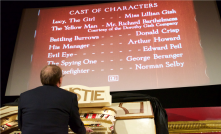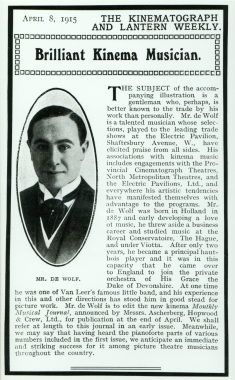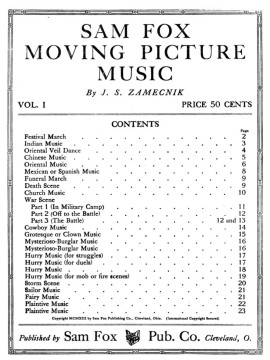 The first of two guest blogs for August! This guest blog is written by Andy Quin. Here he writes about ‘Noisy Organs and Silent Films’.
The first of two guest blogs for August! This guest blog is written by Andy Quin. Here he writes about ‘Noisy Organs and Silent Films’.
Andy Quin
I am an improvising concert pianist and organist whose composing career now spans six decades. My first professional musical engagement was improvising accompaniment to silent movies on the British made Christie theatre organ (a subsidiary of pipe organ makers Hill Norman & Beard in response to the popularity of the American Wurlitzer) at the Astra cinema, Llandudno in 1972. That same year I attended the centenary concert of the Royal Albert Hall organ, where I was much inspired by hearing the great French organ master Marcel Dupré give a recital including an extended improvisation on Three Blind Mice! From then on I was hooked on improvisation. Now with over 1200 published compositions and thousands of broadcasts each year, I am probably one of the most prolific and successful production music composers in the world, providing soundtracks for film, tv, advertising and the media throughout the globe. Improvisation still plays a key role in my work and I am probably the only organist in the world actively improvising music live for silent movies, as well as composing and recording music for current film and tv soundtracks.
A Little History
 At the start of the 20th Century, there was no such thing as film music, silent film presentations were usually accompanied by selections of existing classical and popular music performed live. Musicians, composers and entrepreneurs, such as Meyer de Wolfe in London, edited and arranged selections of such music for appropriate ensembles, and licensed these arrangements to provide suitable accompaniment for this growing entertainment industry.
At the start of the 20th Century, there was no such thing as film music, silent film presentations were usually accompanied by selections of existing classical and popular music performed live. Musicians, composers and entrepreneurs, such as Meyer de Wolfe in London, edited and arranged selections of such music for appropriate ensembles, and licensed these arrangements to provide suitable accompaniment for this growing entertainment industry.
At the same time, the Sam Fox Publishing Company was set up in the US providing short cues of original music suitable to accompany commonly encountered film scenes.

De Wolfe worked at theatres such as the Regent St. Cinema in London, (now recognised as the birthplace of British Cinema where the Lumière brothers first showed moving pictures in the UK, and where I am now resident organist). When sound recording was established, De Wolfe engaged the finest musicians and composers of the era (for example Leon Goossens, Sidney Torch, Stephane Grappelli, Gustav Holst and Florence De Jong) to create a library of recorded music categorised by suitability for a particular scene or emotion; this was the first ‘Mood music’ or ‘Library music’. This ‘Production music’ as it is now called is ubiquitous in film and the media although largely anonymous. But all this comes later, back in the 1920’s Meyer was also involved in importing theatre organs into the UK, (an activity he kept fairly quiet as some in the Musicians Union regarded this new technology as a threat to musicians jobs). As provincial and often quite small cinemas gradually proliferated, and the demand for silent film showings increased, it was obvious that many of these could not economically support a full orchestra or band, and the musical community accepted that a solo piano or organ was often the best option. Theatre organs were purpose made machines for producing all the musical sounds and sound effects needed, and had the huge advantage of being relatively cheap to run and could be operated by a single person. This meant that a single player could effectively generate a soundtrack instantaneously ‘live’ without any prior rehearsal. Anecdotes and stories of these early days of live music accompaniment abound, but from personal experience I can vouch for the fact that early mechanical film projectors are incredibly noisy, it may well be that one of the original reasons for the growth in popularity of live music accompaniment to films, and particularly loud organs, was to help mask the dreadful noise made by the projectors!
Observations of Performance
There is much written about the art and practice of silent film accompaniment and there is not room in an article like this to go into much detail. I am lucky to have met and learnt much about the art, both from acclaimed original practitioners (such as Florence de Jong and Ena Baga), and leading current silent film music experts such as Prof. Julie Brown and Neil Brand. I would thoroughly recommend researching further into this fascinating subject, but I have a few, simple observations from long experience that might be pertinent.
It may seem obvious, but like any form of extemporisation, silent movie music has to happen in real time. Ideally it should be pretty well synchronised to the action on screen, it has to be immediate and there shouldn’t be perceptible delays. As a consequence there is so little time to ‘think’ consciously about what you are doing, the improvisations have to be instantaneous. Like so many skills in life, this is best acquired by regular practise, preferably whilst you are young enough for your brain to develop the connections required to form what is similar in many ways to we often call ‘muscle memory’. Depending on how much opportunity and time I have to see and work on a film beforehand, I will go through the film making a mental note of obvious cue points. This is analogous to ‘spotting’ in contemporary film scoring. I will also look at the characters involved and perhaps try to develop very simple and basic operatic ‘lietmotif’ musical ideas for each character. These themes can then be developed and blended according to how each character is feeling, interacting and what they are doing. I think the most important element here is to underscore or highlight the emotion. If you can add depth to the emotional narrative, even with slapstick comedy, you will hopefully engage the audience. Generally in performance I like to combine my own compositions with well known existing songs and music where appropriate. For example, in his short film ‘The Balloonatic’ (1923), slapstick comedy genius Buster Keaton encounters a bear in the wild. I nearly always accompany this scene with a few bars of ‘The Teddy Bears Picnic’, it usually gets a few laughs!
A huge selection of silent films is available online to download or stream for free, from artistic melodramas to epic spectaculars, SciFi, horror and slapstick comedies. So if you have an instrument available to practise on, why don’t you discover some of these wonderful films, pick one or two and have a go at accompanying them?
Andy on TV
You may not have heard of Andy’s name but you will almost certainly heard a lot of his music! A small selection of his recent film and tv work includes
Widows, Ab Fab The Movie, Victoria and Abdul, Trumbo, To The Wonder,
Mute, Boardwalk Empire, Supernatural, Travelers, Better Call Saul, Parks and
Recreation, The Assassination of Gianni Versace and BBC2’s The Children’s Hospital. Andy’s music is also a staple of the advertising industry ranging from classics such as the ‘Oxo’ family with the late Linda Bellingham to the exclusive use of his music over the last few years by the perfume house Guerlain to accompany all its ads featuring Angelina Jolie and directed by Terence Malick.
With nearly 40 years in recording studios working with the world’s finest musicians and orchestras, Andy has recently been using Artificial Intelligence technology to compose and record his 90th album for his publisher, De Wolfe Music. However, he is also now enjoying a renaissance in live performance, and is delighted to bring a lifetime of experience and the joy of improvising music to hopefully introduce a new audience to the appreciation and enjoyment of silent film accompaniment.
A short film about Andy’s work accompanying silent movies on organ is available here:
Links to his biography at De Wolfe Music and some of his current soundtrack work here:
If you would like to write a ‘Monthly Feature’, do please get in touch. It can be about anything to do with the organ. Perhaps your experience on a course you’ve attended, buying a new organ, the day in the life of an organ builder, my favourite organ. I’d love to hear from you!
Categories: Uncategorized




Thanks for this Anna!
On second reading I notice it is a bit egocentric but hopefully still has some information and entertainment value! ; )
Have a great summer,
All best,
Andy
Sent from my iPhone
>
LikeLike